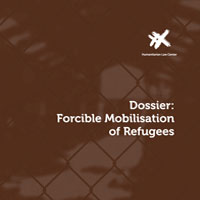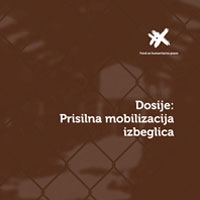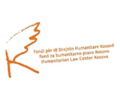Dossier: Forcible Mobilisation of Refugees
 From the outbreak of war in Croatia and BiH, and especially in connection with the Croatian military-police operations “Flash” and “Storm”, about 500,000 Serbs, citizens of Croatia and BiH, fled to Serbia. Tens of thousands of Serbs from Croatia fled to Serbia during 1991 and 1992. They mostly exchanged their houses and property with Croats from Vojvodina, who, under pressure from the Serbian Radical Party and paramilitary groups, left Serbia. At least 200,000 people fled Croatia from May until the end of August 1995, during and after the “Flash” and “Storm” operations of the Croatian Army and the MUP. Most of the refugees were accommodated in reception centres across Serbia, in old hotels, unused public facilities, or with relatives and friends, and only a few were able to rent an apartment.
From the outbreak of war in Croatia and BiH, and especially in connection with the Croatian military-police operations “Flash” and “Storm”, about 500,000 Serbs, citizens of Croatia and BiH, fled to Serbia. Tens of thousands of Serbs from Croatia fled to Serbia during 1991 and 1992. They mostly exchanged their houses and property with Croats from Vojvodina, who, under pressure from the Serbian Radical Party and paramilitary groups, left Serbia. At least 200,000 people fled Croatia from May until the end of August 1995, during and after the “Flash” and “Storm” operations of the Croatian Army and the MUP. Most of the refugees were accommodated in reception centres across Serbia, in old hotels, unused public facilities, or with relatives and friends, and only a few were able to rent an apartment.
Pursuant to an agreement between the RSK, RS and Federal Republic of Yugoslavia (FRY) authorities, in January 1994, military and police authorities began to practice the forcible mobilisation of the refugees. From May until the end of September 1995, members of the MUP massively arrested refugees from Croatia and BiH and then handed them over to RS and RSK military, police and paramilitary units. According to HLC data, the Serbian Ministry of the Interior forcibly mobilised around 10,000 refugees during the summer of 1995 and returned them to the territory controlled by the Army of Republika Srpska (VRS) or Serbian Army of Krajina (SVK). At least 54 forcibly mobilised refugees lost their lives or disappeared after returning to areas where armed conflicts were taking place.
By returning refugees to those war-affected areas, Serbia violated the Convention on the Status of Refugees and the Law on Refugees of the Republic of Serbia, whose provisions prohibit the return of refugees to the territory where their lives are endangered, and violated the obligation of the receiving state to ensure that refugees can live their daily lives in conditions of dignity.
From April 1996, the HLC has filed claims for damages before the courts in Serbia on behalf of about 720 forcibly mobilised refugees, some of whom were wounded or captured during the time spent on the battlefield, as well as on behalf of family members of forcibly mobilised refugees who died on the battlefield after being sent to VRS or SVK. The claims were filed for violation of rights to liberty and security of person, as well as for the death of a close family member. In all of these cases, the courts have held Serbia accountable, as members of the MUP have violated both the 1951 Convention on the Status of Refugees and the Law on Refugees, which was in force in Serbia at the time, thereby causing damage to the forcibly mobilised persons.
Dossier Forcible Mobilisation of Refugees is available here.







